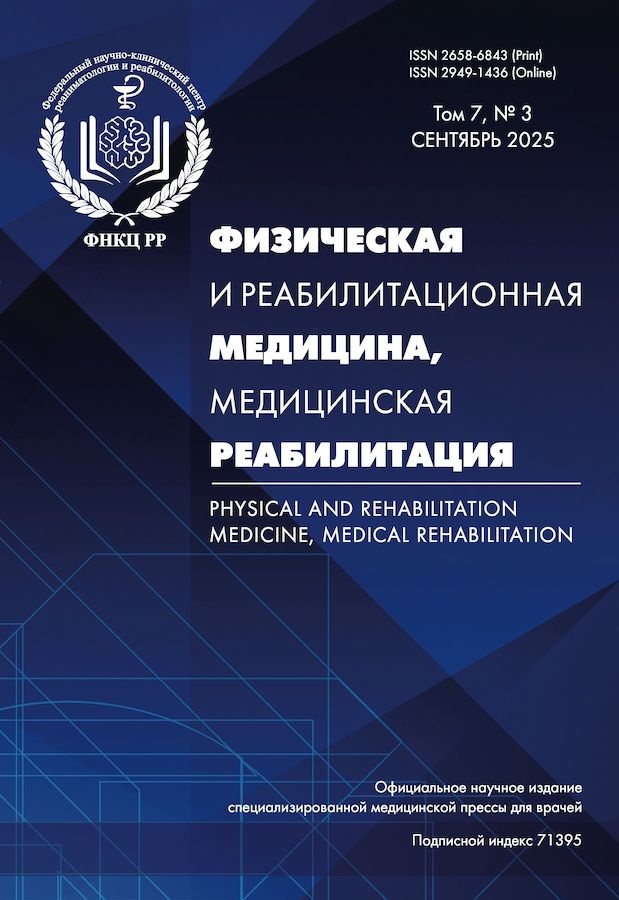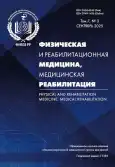Vol 7, No 3 (2025)
ORIGINAL STUDY ARTICLE
Changes in pulmonary function and exercise tolerance in patients with COVID-19 pneumonia following a course of medical rehabilitation including personalized normobaric hypoxic–hyperoxic therapy
Abstract
BACKGROUND: Persistent sequelae of COVID-19, collectively referred to as long COVID, are a key concern in modern pulmonology and rehabilitation medicine. Among these, impaired pulmonary function and reduced exercise tolerance are predominant. Rehabilitation of such patients requires a comprehensive and individualized approach.
AIM: This study aimed to evaluate the effects of comprehensive rehabilitation, including personalized normobaric interval hypoxic–hyperoxic therapy, on hypoxia tolerance, pulmonary function, and exercise capacity in patients recovering from COVID-19 pneumonia in a day hospital setting.
METHODS: A total of 120 day hospital patients who had experienced moderate COVID-19 pneumonia were randomized into two equal groups. Sixty patients in the control group received a standard 10-day rehabilitation program (therapeutic exercise, hydro-kinesiotherapy, selective chromotherapy, halotherapy, and psychoemotional relaxation sessions). Sixty patients in the intervention group received the same standard program plus daily personalized normobaric interval hypoxic–hyperoxic therapy sessions for 10 days. Hypoxia tolerance was assessed using Stange and Genchi tests, pulmonary function was measured via spirometry, and exercise tolerance was evaluated with the six-minute walk test before and after rehabilitation in both groups.
RESULTS: Both groups demonstrated statistically significant improvements (p <0.05) in most parameters after rehabilitation; however, the intervention group showed superior improvements in hypoxia tolerance, pulmonary function, and exercise capacity compared with the control group after rehabilitation. No adverse events or reactions related to the intervention were reported.
CONCLUSION: Adding personalized normobaric interval hypoxic–hyperoxic therapy to standard day hospital rehabilitation for patients recovering from COVID-19 pneumonia significantly enhances hypoxia tolerance, pulmonary function, and exercise capacity.
 168-177
168-177


Clinical significance of physical performance assessment during systemic anticancer therapy: a cohort study
Abstract
BACKGROUND: Advances in oncology have contributed to increased survival among patients. Cardiovascular toxicity remains a significant concern in women with breast cancer undergoing anticancer therapy. Conventional methods for assessing cardiotoxicity, primarily based on left ventricular ejection fraction, have limited prognostic value and may not fully reflect post-treatment functional decline and reduced quality of life.
AIM: This study aimed to evaluate the contribution of various physiological factors to reduced physical performance in patients with breast cancer receiving anthracycline-based chemotherapy.
METHODS: This cohort study included 30 patients with breast cancer undergoing neoadjuvant anthracycline-based chemotherapy. Comprehensive assessment comprised echocardiography, laboratory tests, psychometric questionnaires, and the six-minute walk test. Statistical analysis included correlation and regression analyses to identify predictors of reduced physical performance.
RESULTS: Most patients were overweight or obese and had concomitant anemia and hypertension. Patients with low daily physical activity more frequently exhibited a 10% decrease in left ventricular ejection fraction over the past 3 months and poorer performance on the six-minute walk test. Multiple regression analysis identified anemia severity, hypertension level, reduced left ventricular ejection fraction, and the number of chemotherapy and radiotherapy cycles as significant predictors of decreased physical performance. Psychoemotional disorders and treatment adherence did not have a statistically significant impact.
CONCLUSION: Reduced physical performance in patients receiving anthracycline-based chemotherapy for breast cancer is driven by a combination of cardiovascular, pulmonary, and hematologic factors. The study was limited by a small sample size. Future research should focus on the development of personalized rehabilitation programs aimed at minimizing cardiotoxic effects and restoring functional capacity in patients with cancer.
 178-189
178-189


Analysis of bacteremia profiles in patients with chronic critical illness undergoing treatment and rehabilitation in intensive care units
Abstract
BACKGROUND: Bacteremia is a serious clinical condition that often precedes or accompanies sepsis and septic shock, which remain leading causes of hospital mortality worldwide. Understanding the epidemiology of bacteremia—including antimicrobial resistance patterns—and treatment principles is critical for improving outcomes in patients with chronic critical illness and severe brain injury.
AIM: This study aimed to determine the profile of bacteremia in patients with severe brain injury in predominantly chronic critical illness admitted to intensive care units from 2018 to 2024 and their antibiotic susceptibility; to identify common resistance mechanisms of leading pathogens; and to formulate recommendations for optimizing antimicrobial therapy in this population.
METHODS: The study included patients with severe brain injury in predominantly chronic critical illness who developed clinically significant bacteremia. Microorganisms were identified, and antibiotic susceptibility was determined using the BD Phoenix 100 automated analyzer. Susceptibility interpretation followed EUCAST criteria.
RESULTS: Among 292 patients in predominantly chronic critical illness, the top ten bacteremia pathogens were primarily Gram-negative organisms, including Klebsiella pneumoniae (40.11%), Pseudomonas aeruginosa (6.22%), Proteus/ Providencia spp. (5.94%), Acinetobacter baumannii (5.37%), Serratia marcescens (4.24%), Escherichia coli (3.10%), and Enterobacter cloacae (1.69%). During this period, high carbapenem resistance was observed in Klebsiella pneumoniae (84.29%) and Pseudomonas aeruginosa (61.90%). Among Gram-positive organisms, coagulase-negative staphylococci predominated (21.47%).
CONCLUSION: Gram-negative bacteria with high levels of antibiotic resistance, including carbapenem-resistant Klebsiella pneumoniae and Pseudomonas aeruginosa, were the predominant pathogens in bacteremia among patients with chronic critical illness in intensive care units. Establishing effective empirical antimicrobial therapy protocols requires analysis of local antibiotic susceptibility data.
 190-200
190-200


REVIEWS
Development of the modern medical rehabilitation system in Russia: a review
Abstract
The development of Russia’s medical rehabilitation system is a healthcare priority, driven by the high prevalence of disability and the need to improve life expectancy and quality of life. This development draws on international experience with multidisciplinary, patient-centered approaches and the contemporary global political context. Recent years have seen significant progress in establishing the regulatory framework, developing federal programs, and implementing pilot projects to create a multi-tiered rehabilitation model that has proven clinically and economically effective. Modern medical rehabilitation is organized around the principles of early intervention, continuity of care, multidisciplinary collaboration, and individualized, patient-centered approaches.
The persistent need to identify effective organizational models and implement team-based practices that improve the functioning and social integration of individuals with disabilities drives the continuous evolution of the rehabilitation system. Innovative technologies are being actively introduced, including telemedicine services, robotic systems, and digital educational and diagnostic tools. The expansion of digital and telemedicine instruments facilitates continuous patient monitoring and remote management, aligning with global healthcare trends. Despite these achievements, systemic challenges persist, including workforce shortages, insufficient digitalization of processes, and the gaps in the regulatory framework. The continued development of rehabilitation services is expected to improve healthcare accessibility and quality, thereby strengthening the country’s socio-economic potential.
 201-210
201-210


Modern technologies for post-stroke shoulder joint rehabilitation: combining evidence-based methods and promising technologies: a review
Abstract
Shoulder joint dysfunction after stroke, observed in 12%–64% of patients, leads to pain, the development of contractures and subluxation, significantly reducing patients’ quality of life and complicating their rehabilitation. To confirm that rehabilitation of shoulder joint dysfunction after stroke is a complex but achievable task, an analysis of 38 scientific articles published between 2014 and 2025 was conducted. A search of articles was performed using keywords in open-access databases including PubMed, Cochrane, eLIBRARY.RU, and Scopus. All materials relevant to the research topic and published in Russian and English were included in this review. This review presents a brief overview of shoulder joint anatomy and current evidence-based methods for restoring shoulder function impaired as a result of cerebrovascular disorders. Both traditional (orthoses, taping, braces, botulinum toxin therapy) and innovative (functional electrical stimulation, robotic therapy, virtual reality, computer vision, and artificial intelligence) technologies were analyzed. Emphasis is placed on the importance of early initiation of rehabilitation, focusing on scapulohumeral stabilization; a personalized comprehensive approach based on the degree of paresis, spasticity, and stroke stage; integration of high-tech solutions into clinical practice; and combining different rehabilitation methods, which is more effective than monotherapy. The results demonstrate that modern comprehensive rehabilitation strategies create new prospects for upper limb function recovery whereas highlighting the need to adapt novel tools for real-world clinical practice to improve the quality of life in patients after stroke.
 211-220
211-220


Myocardial injury in COVID-19 and cardiac arrhythmias in acute and long-term periods
Abstract
Epidemiologic data indicate that up to 30% of individuals surviving the acute phase of COVID-19 experience persistent cardiovascular symptoms, including dyspnea, chest pain and discomfort, palpitations, exercise intolerance, pathological fatigue, and sleep disturbances. Numerous investigations worldwide have shown that patients, regardless of age, race, sex, or cardiovascular risk factors, remain at increased risk for cardiovascular complications after recovery from COVID-19, including new-onset or progressive inflammatory heart diseases, heart failure, myocardial infarction, ischemic heart disease, cardiomyopathy, thromboembolism, cardiac arrhythmias, and ischemic stroke. SARS-CoV-2 not only induces direct cardiomyocyte injury or damages other cardiovascular system cells but also causes systemic inflammation and coagulopathy, which may exacerbate comorbid cardiovascular diseases. Functional and instrumental diagnostic methods have revealed various forms of subclinical and clinical cardiac injury in most patients with post-COVID syndrome, regardless of the severity of the acute COVID-19 phase or coexisting conditions. The high prevalence of post-COVID cardiovascular syndrome underscores the need for a comprehensive, multidisciplinary approach to diagnosis, treatment, and rehabilitation. Authors of published investigations, meta-analyses, and systematic reviews consistently emphasize the importance of monitoring cardiovascular status for at least one year after recovery from infection.
This review article highlights the need to investigate the pathophysiology of post-COVID cardiovascular syndrome to identify potential therapeutic targets and develop targeted treatment strategies.
 221-242
221-242


CASE REPORT
Effectiveness of comprehensive postural and pulmonary rehabilitation in a child with cerebral palsy and comorbid pulmonary pathology: a case report
Abstract
The presented clinical case highlights the need for effective rehabilitation strategies for children with combined motor and pulmonary impairments. Cerebral palsy and bronchial asthma often coexist, exacerbating each other’s course, reducing motor activity, and impairing quality of life. Although these conditions are well-studied individually, rehabilitation strategies addressing both within a single program remain poorly described. This case illustrates the integration of postural and pulmonary therapy and their synergistic effects.
The patient was a child with cerebral palsy (Gross Motor Function Classification System [GMFCS] level III; Manual Ability Classification System [MACS] level II), moderate spasticity of the lower extremities according to the Modified Ashworth Scale, and impaired static trunk control assessed by the Segmental Assessment of Trunk Control (SATCo) system (instability in thoracic and lumbar segments). Comorbid bronchial asthma manifested as recurrent dyspnea, reduced forced vital capacity (62% of predicted), and peak expiratory flow less than 120 L/min. The rehabilitation program included static postural correction with orthoses, diaphragmatic breathing and forced exhalation exercises, gentle manual therapy, massage, and physical exercises. After 6 weeks, improvements were observed in trunk control, forced vital capacity increased to 78% of predicted, peak expiratory flow improved to 180 L/min, frequency and severity of asthma attacks decreased, and overall motor activity improved.
This case demonstrates the effectiveness of a comprehensive interdisciplinary approach in rehabilitating children with multiple impairments. Simultaneous intervention targeting both pulmonary and motor functions may enhance adaptive reserves. Although data are limited to a single case, these findings support the potential effectiveness of integrative programs, warranting further investigation.
The case underscores the potential of personalized rehabilitation strategies to improve quality of life and functional independence in pediatric patients.
 243-250
243-250









